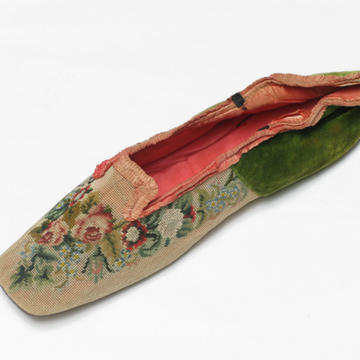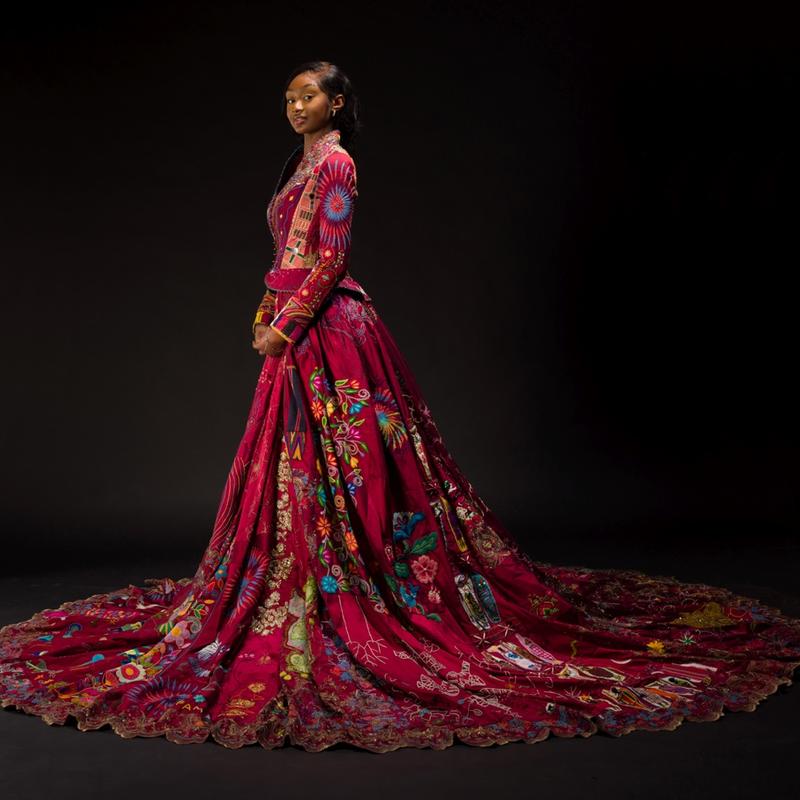This recent Micro-Internship project will help inform the content of a forthcoming display on 19th century embroidery in the collection at Tyntesfield House, with a particular focus on amateur creativity. The following blog reflects on Annabel's experience.
As part of the National Trust partnership with Oxford University, I spent a week on a micro-internship working with the collection at Tyntesfield House. My focus for this project was embroidery; alongside the upcoming Red Dress exhibition which will be taking place at the house, embroidery from Tyntesfield’s collection will be displayed. The Red Dress is a long-running project which involved embroidery from all over the world which focuses on women’s experiences and personal identity. It was my job to explore the collection at Tyntesfield and find pieces which would work in an exhibition and explore how to categorise them.
This was a daunting task – the collection at Tyntesfield holds tens of thousands of objects, and even when searching specifically for ‘embroidered’ or ‘embroidery’ there were over 300 items to look through. Within this, there was much that I was expecting to find, such as samplers and children’s embroidery, or embroidered clothing. The clothing and accessories were particularly fun to work with as they were so decorative; the embroidered shoes in the collection stood out to me as they weren’t something I was expecting to find and are still very beautiful – I would love to wear them!

Fig. 1 Tyntesfield Slipper © National Trust Tyntesfield
Yet, as embroidery is quite a new area for me, there was more variety in the collection than I was originally anticipating finding. The extent of the embroidery and decoration on many of the religious items was of particular interest to me, leading me to research further into their uses and the connection to the Gibbs family. The orphreys, decorative bands on vestments worn during ceremonies, were unfamiliar to me and so led to investigation on 19th century religious clothing. From this, I was able to make connections between the Gibbs’ links to the Oxford Movement and suggest how the principles of the movement affected the objects. It was fascinating to think about how the imagery on the items and the highly decorative nature could be linked to the focus on sacrament and ‘high church’ of the Oxford Movement.
Working with material objects in such detail was quite unfamiliar to me, as most of the history I do at university is based on written sources, and so I greatly enjoyed this opportunity to study embroidery in focus. As I had never worked with embroidery before, it was a steep learning curve, but I found that the nature of the internship, looking at the objects in preparation for an exhibition, was a great introduction to the area. It also gave me a very useful insight into one area of work at a National Trust property; throughout the week we spoke to various people within the National Trust which was incredibly informative and valuable! I greatly enjoyed my week and would love to do something similar in the future. I am also looking forward to visiting the exhibition at Tyntesfield this May!

Fig. 2 Lekazia Turner © The Red Dress Project - Mark Pickthall
Annabel Thomas (she/her) is a second year Ancient and Modern History undergraduate student at Somerville College, Oxford. She has enjoyed visiting many National Trust sites over the last few years, and is interested in working in the heritage sector post-degree.
The Red Dress at Tyntesfield: The award-winning global collaborative embroidery project, the Red Dress, is showing at Tyntesfield until 4th June 2023.
The Red Dress project features one dress that has been embroidered on to by people around the world over the course of 13 years, many of whom are vulnerable and live in poverty. To discover more about the Red Dress project, visit www.reddressembroidery.com.
The Red Dress will be on show in the Drawing Room of Tyntesfield House. The exhibition will also feature the 'Threads of Tyntesfield', with footstalls, firescreens, samplers, slippers and shawls on display in the Organ Room. Many of the embroidered objects in the National Trust’s collection at Tyntesfield were made, worn, bought or collected by the women of the Gibbs family, and have not been on display in the house before.
Entry to the exhibition is free and no booking is required. Normal admission applies. More info here.
Find out more about the National Trust Partnership here.
Find out more about the TORCH Heritage Programme here.